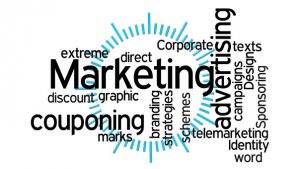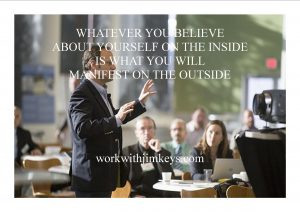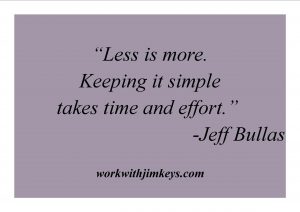- You are here:
- Home »
- Author's archive:
All posts by Jim Keys
A Positive Difference in the Lives of Your Customers

In your business, you can make a positive difference in your customers’ lives by being:
- A meaningful contributor and making a real difference in helping them reach their goals;
- A force of optimism and giving them hope and encouragement. Talk about bad events as temporary and good events as long-lasting;
- Intentional in your actions such as really listening to their challenges and concerns and working to help them find solutions;
- A student learning from your experiences of helping others and applying what you learn by giving value and making a positive difference.
The Four Branding Questions You Must Answer

Building a strong brand isn’t difficult, but it does require focus. It’s not uncommon for new business owners—and experienced ones, too—to drop the ball when it comes to branding. It’s not that they don’t know what they’re doing. Rather, it’s that they can’t articulate it.
The good news is that there’s something you do about it. Answering four key questions about your brand can help you focus on what’s most important. And that will make it easy to create a consistent and memorable brand.
Question #1: If your brand were a person, what three personality traits would it have?
It might seem strange to attribute human traits to a brand, but it’s one of the most essential elements of branding. Brands have personalities, or they should. Why? Because consumers want to identify with a brand. Often, they project themselves onto the brands they use.
A brand like Dove might choose these traits: warm, compassionate, and confident. A quick perusal of their website or Facebook page shows all three traits in spades. Their content celebrates women as they are, and encourages followers to share their stories.

Question #2: Which celebrity would you choose to narrate a documentary about your brand?
The second question is one that can help you determine the right voice to use for your brand. A brand’s voice should spring from its personality. It’s important to think about tone, language, and who the audience is for your brand.
A brand that targets affluent people who care about appearances might choose someone like Sean Connery or Gwyneth Paltrow. A young, hip brand might prefer a very different narrator. The key is to come up with someone who would be a good spokesperson for your brand.

Question #3: How do you want a prospect to feel when they read about your brand?
Branding is a two-way street. Ultimately, you want people to identify with your brand. They can only do that if their reaction to it is something you consider. You can’t control how people react, but a carefully created brand is likely to evoke the emotions you want your customers to feel.
A brand like Nike, for example, might want its followers to feel these emotions: empowered, inspired, and strong. You can see these feelings being evoked by their slogan, Just Do It, which encourages people to pursue their athletic goals and overcome any obstacles in their path.

Question #4: What characteristics do the people in your target audience have in common?
Your fans and followers aren’t all the same, but the chances are good that they share some common traits that can help you create a strong brand that appeals to them. These characteristics may be demographics, or they might be personality traits like the ones you assigned to your brand.
A brand like Red Bull, which uses a rather brash, irreverent tone in its marketing, might identify the following traits for its customers: young, daring, and unconventional. By contrast, a brand like Rolls Royce might choose words like affluent, educated, and status-conscious.
The words you choose should describe your target audience. They can also help you define and flesh out your brand so that it attracts the people who are most likely to buy from you. In other words, they work in concert with your brand’s personality and voice.

Creating a memorable brand is a cornerstone of good marketing. When your brand is clearly defined, it will inform every aspect of your marketing. The voice, characteristics, and feelings you want to evoke will show up in every email, social media post, and ad campaign you run.
If you’d like more marketing tips like these, please click here to learn how my done-for-you system can help.
Best Chrome Browser Extensions for Marketing

If you’re anything like me, your head is always full of to-do lists, passwords, reading material, and so many other things you can’t possibly remember. We all need a little help sometimes.
Especially in the world of digital marketing, there’s always a social media account to manage, marketing materials to write, and influencers to find. There are plenty of resources available to make life easier. Here are just a few that can help you organize your brain dumps.
Evernote Web Clipper
If you regularly save articles to reference later or take screenshots, Evernote helps to organize these things, so you don’t lose track of them. You can keep your bookmarks and tabs under control, while never forgetting where that article was that you wanted to read.
OneTab
My husband is the king of tabs. It drives me crazy. All the way across the top of his screen are these toothpick-sized things you can’t possibly click on let alone know what they are. Somehow, he still knows what every single one of them is and can return to it in a flash while I remain stumped as to how he can work that way. Until he asks me if I can find something on his computer for him. Um, no. I can’t.
Enter OneTab. The OneTab Chrome extension closes web pages but saves their URLs in a tab for reference later. You can feel better about ‘closing’ those tabs, knowing you can quickly return to them later.
Save to Pocket
Save to Pocket allows you to tag references, reading materials, and other examples for use later with just one click. The tags you assign allow you to sort them so you can keep organized notes for each blog, task, or assignment.
Grammarly
Grammarly is a glorified spell-checker. Plop text for your next blog post, email, or a web page in the form, and it can identify improper grammar, word usage, punctuation, overused words, and more. It also suggests changes, so you spend less time editing.
KUKU.io
KUKU.io helps you to schedule content for social media with a click. You can also share to multiple networks at the same time. Adapt your post to specific mediums with hashtags, pictures, or original content.
EmailHunter
You no longer have to search endlessly for contact information. EmailHunter finds the email addresses of your leads from LinkedIn pages or a company website and shows you confidence in the source with a percentage of reliability. You can use this service in conjunction with Rapportive to see if an email address is valid.
Rapportive
This extension validates the emails you add as recipients when drafting an email in Gmail. It helps you to reduce your bounce rate and associates each email with LinkedIn and other social profiles so you can gain valuable insights into your contact list before communicating.
Sidekick by Hubspot
Check open and click rates for your emails to help with statistics and tracking. You can schedule emails for later or review your activity history. Hovering over an email address shows the person’s title, company, social profiles and recent tweets.
Giphy for Chrome
Search GIFs and add them to social media posts and emails by dragging and dropping. It’s fast and easy, with a massive library of relevant images, leaving you more time to draft meaningful content.
These should get you started down the path of time savings, organizing your thoughts, and creating more content to increase traffic and conversions. By keeping you sane, these tools reduce stress and condense your ideas into one easy-to-remember place. Check out my done-for-you system for more organization ideas.

Believe in yourself…

All throughout life I was able to face countless challenges because I believed in myself. That belief allowed me to cast away the fear and self-doubt that tried to creep in. I believed. I saw in my mind success. And, it became so.
Creative Lead Generation in your business

Lead generation is a vitally important part of a digital marketing strategy. If you don’t have leads, people don’t get your emails. Emails generate sales, foster public relations, and give you a place to talk to your customer. Having leads for those emails is a must.
Getting new leads can sometimes be difficult. More and more people are choosing to not opt into emails and this can leave your lead list flat and your email delivery stagnant.
People are more apt to share their emails with you if they feel like they are getting something of genuine value by sharing them. Here are a few creative ways to capture leads that convert.
Use success stories
Odds are that you have at least a few success stories from thought leaders in your industry. Reach out to them and interview them. Turn that interview into a webinar, podcast, or articles.
A conversation with a thought leader about how they became successful is a compelling and valuable piece of content. When you share this content, lead lock it. People who really want to see the content will be more than happy to give you their email in exchange for advice from a thought leader.
Make “Help” videos
Making help videos is another great way to capture leads. If there is a problem that you see a large number of people who use your service having, such as “how do I create a Facebook page” or something of the like, make a video solving the problem.
Not only do these videos provide useful information for your clients, they can also help you gather new customers and clients by helping them solve their problem.
For the best payoff from help videos, create an education center page on your website with a few videos. Have people provide their email address to sign-up and use the free education center. This gives you valuable leads that can turn into new customers.
Embrace the quiz trend
Quizzes are big right now. They are all over social media and have started to creep into display ads and email inboxes. Use the quiz trend to your advantage.
Quizzes, especially when they are created well, are a great lead generation driver. People love learning what kind of flower they are or which celebrity they act like the most. Usually, the more outlandish the quiz, the better.
Quizzes are also great to push out on social media for some new engagement and boosted traffic and likes on your company’s page. Use the power of the quiz for all it’s worth and it will deliver a host of great results.
Give insight into what’s working for you
Have something you are doing that is working really well for you? Talk about it! Host a webinar about it or write a blog or whitepaper. People want to know what works for others and they are more than willing to exchange their email for that information.
Be an information provider and people will start to look to you as an authority. Consider using the pieces as a lead generation ad on Facebook and test the response.
Host a giveaway
Giveaways are one of the easiest and frankly the best ways to gather leads. When you create a great giveaway, people will happily give you their email address for a chance to win.
Giveaways do require some careful consideration when you are using them for lead generation though. You have to be prepared that some people who enter the giveaway may have little to no interest in your company and won’t be good leads.
That being said, giveaways are still a great lead generation tool and can give you a ton of leads in a short amount of time. This is especially true if you use social media to promote the giveaway.
Want to learn more about getting great leads? Check out my done-for-you system today!
Are your actions counting…

Ask yourself if what you are doing today is getting you closer to where you want to be tomorrow…
Social Media Shares Don’t Equal Successful Content

Whenever you create content, you probably want it to get shared with a lot of people. After all, shares mean that people have engaged and that your content must be amazing. Actually, this isn’t the case.
While, yes, good content gets shared, shares aren’t the only indicator of powerful content and engagement. There are a whole slew of other factors that influence the power of your content on social media.
Ideally, your content gains both shares and links. That makes your content valuable and boosts your authority on search engines and social networks. This is called amplification.
A good amplification strategy makes the difference between a good digital marketer and a great digital marketer. This article will help you develop the tools to create a great amplification strategy to take your content to the next level.

Why have an amplification strategy
Having a good amplification strategy means that your content will be seen by a large number of people who will perform the action you want them to. Social platform shares don’t mean anything unless people are performing the type of engagement with your content that you want.
Now it takes more than just publishing your content to get people to react to it and act on it. You have to have an amplification strategy to take it to the next level. A good amplification strategy will get your content to the right people at the right time who will perform the right action with it.
A social sharing doesn’t equal amplification strategy
If you want to build an amplification strategy, you need to go beyond social shares. Social platforms are powerful discovery tools but their amplification strategy benefits are minimal. There are too many amplification limitations to social sharing to make it a proper amplification strategy.
This is because, more often than not, shared links aren’t clicked, shared content is frequently not read by the sharer, social shares have a short shelf life, and sharing goes down after a few days. This makes social sharing minimally beneficial when it comes to amplification. Sure, it can work sometimes, but it often doesn’t work.
Lots of shares don’t mean lots of likes
People share and like content for different reasons. For example, people share content when they find something entertaining, when they want to foster a personal relationship, when they want to show that they support a cause, when they want to share helpful content, and when they want to show that they are part of the tribe.
People like content when they view it as an authority, they support the content, the content is unlikely to change, and/or the content serves as a helpful guide. Something is shared and liked when the content is valuable and helpful. That’s the area you want your content to live.
Getting shares and likes
There are a few ways that you can get your content to get shares and likes:
- Answer a common question that people have regarding your area of expertise
- State strong and/or controversial opinions
- Post original research and data you have collected yourself
- Develop a real amplification strategy
That last point is where you, as a digital marketer, need to focus. You need to develop an amplification strategy and here is how you do it.
Developing an amplification strategy
A good amplification strategy uses five main tactics: manual promotion, target mailings, influencer advocacy, link building and SEO, and paid promotion. Each of these tactics helps you build a real amplification strategy.
Each business uses these differently, so it is best to get together with your web and marketing team and come up with a way to make all those tactics work for you.
If you are looking for a way to build and amplification strategy for your business, take a look at my done-for-you system today.

Why Your Mailing List Is Your Most Powerful Online Marketing Tool

The number one way to really convert website visitors into actual customers is through email correspondence. I can’t tell you how many times this has personally worked on me. A company sends an alluring email, you open it, and then realize that hey, this is really cool and the next thing you know, you’re about to check out your cart.
This is the real power of email marketing, which many online business owners might underestimate as a powerful lead generating and conversion force. The idea of being an online business does not negate the need to connect with individuals, and emails provide a convenient and also effective way to accomplish that. This means that if nothing else when visitors come to your site, this is the one piece of information you want to ask them to leave with you before they go.
A large following on Twitter or Facebook and other social media platforms will never guarantee you the levels of conversion and profitable traffic that email will. In fact, if you get on to platforms like LinkedIn, which has millions of business contacts and prospects, you can get information which will springboard you into making connections and grow your business to proportions you never thought possible.
The Benefits of Email Marketing
- Email marketing provides you with a direct and safe way to interact with customers, and present the offerings of your business to them. The awesome thing is that you get to control the frequency of your emails and also personalize them for your audience.
- Research has shown that return on investment rates produced as a result of email interactions, are the greatest you will ever receive, than from any other marketing method you use. This means that your company really needs to go all out in terms of collecting email information from prospective clients, and on members in your target groups to really get in on this cash cow.
- In addition to desktop users, you can reach a wider number of prospects who view emails on their mobile devices. This further increases your scope to make connections, which means that your business will have to consider formatting these emails to be displayed attractively on smaller mobile screens, not just desktops. Don’t run the risk of having your valuable messages deleted because they don’t display well on a mobile screen, so cover all the bases, and don’t let this be a cause for loss of revenue.
- All you need is an interest-catching subject line to encourage your reader’s further interest in exploring the message. You may also choose not to make your message too lengthy. Keeping it simple may be very appealing especially to busy people and also appear more personal.
- You can easily combine your email marketing efforts with social media marketing, by using videos for example, in the body of your email, which can then easily be shared on social media platforms to greatly increase the scope of your reach.
How To Get Your Hands On Mailing Lists
You can acquire email subscriber lists through the database that you have created on your own website. Additionally, you can reach out to mailing list brokers who will provide you with targeted lists, based on your specifications, for a fee. Alternatively, you can get this information through public records, although it may not be as profitable for you as your own company list or a purchased targeted listing.
If you feel that you need additional help in generating profitable leads, just click on this done-for-you system link, where you will find out more about effective lead generation strategies.

How To Use Targeted Ads To Generate Traffic With Facebook

With the billions of people who use Facebook all over the world, this platform represents a gold mine when it comes to reaching people and generating traffic for your online business. As an entrepreneur, you always have to be thinking about the most effective ways to raise the profitability of your business and this seems to be one of the obvious choices.
We’re not just talking about free advertising. Using the free method gives you a much smaller scope of reach than paid advertising would with Facebook. You can choose the frequency and the scope of your campaign, and also determine how to position if your business offering fits in with their advertising models.
How To Do It?
You have the option of promoting your business through posts made on your page, directing users to your website, and Facebook page promotion. What will prove most effective for you, is to have users directed to your website, which shifts the focus from your Facebook page and has prospects looking where the real action takes place. This is what will increase your chances of making an actual sale.
Through Facebook’s platform, you’d already have made choices as to the demographic you’re interested in reaching so each visitor is a potential client. You’re already attracting the kind of traffic you’re looking for.
Develop The Art
You need to bear in mind that Facebook users in most cases are looking to connect with people they know or are seeking out acquaintances. Their primary focus tends not to be on making a purchase. You will find though that pages offering a service tend to do pretty well. You’ll therefore need to consider how to create a catchy ad, which will capture your audience’s attention and urge them to consider giving you more than passing glance.
The ideal approach is not to try to fill an already existing need; ads are full of this. You want to create a demand, which is more likely to get you noticed and followed. Of course, the objective is always to move the traffic to your website.
How To Properly Target?
Facebook offers you so many choices in terms of deciding which categories of individuals you want your ads to target. Among the most important categories are location, gender, age and interests.
You really want to zoom in on the matter of the interest of your audience and we’re not just talking about their general interests only. While this may be somewhat helpful in determining what might be appealing to them, the real winner is the specific interests they’ve listed on their profile.
In looking at their specific interests, you also want to take it a step further by researching just how much those interests mean to them. This will allow you to really fine tune your target audience so that your likelihood of traffic generation and ultimately conversion, will increase.
Ad Structure
You also want to give attention to the structure of your ads in order to target properly. You can use original, purchased or (legally) free images to promote your ad. Choose carefully so that your image will speak to or resonate with your targeted audience.
Use clear and concise text with an easy to read and understand message. This is where you’ll have to find your creative side, or draw on the expertise of someone, paid or otherwise, who can assist you with wording.
If you have a business model that will allow you to make effective use of Facebook’s advertising platform, then learning how to utilize it effectively will help you create targeted ads for the right demographic. Making use of the tips provided and taking the time to get familiar with the ins and outs of the advertising platform, will generate traffic and revenue for your online business.
If you feel you need additional help in using Facebook to target and promote to your audience or interest group, just click on this done-for-you system link.
Keeping internet marketing simple…

Recently I read an article by Jonathan Gardner titled “Keep it Simple: a new mandate for marketing.” Jonathan argued that keeping marketing simple benefited the brand, publisher, and especially the consumer. In fact, keeping it simple will be more successful at engaging customers and increasing sales.
